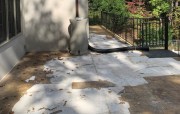Laser scans of a building under construction can tell you many things—maybe some you don’t really want to know, like where you are out of tolerance. In general, though, laser scan data on a building is very valuable to the contractor and the owner from a quality assurance vantage.
At the World of Concrete a few weeks ago, the American Society of Concrete Contractors sponsored a second workshop on laser scanning with the ultimate goal of producing an ACI document, the “Guide to Using 3D Laser Scanning for Measuring Concrete Tolerances.” With a roomful of contractors, surveyors, and equipment manufacturers, the workshop focused on best practices for reducing the error when scanning a building, such as how best to set up the scanner, how and when to calibrate the instrument, and what to do about site obstructions.
An important discussion revolved around a study conducted last fall, and reported on in an article in the January 2019 issue of Concrete International magazine, where eight different people using different instruments scanned portions of a building in California to compare the results. In some cases the error among different scans was greater than the specified tolerance. Using the scanners to measure F-numbers was generally effective: FL results were comparable to those measured with a Dipstick, but FF numbers from the scanner tended to be a bit higher.
The first six chapters of the scanning guide are now in draft form.



